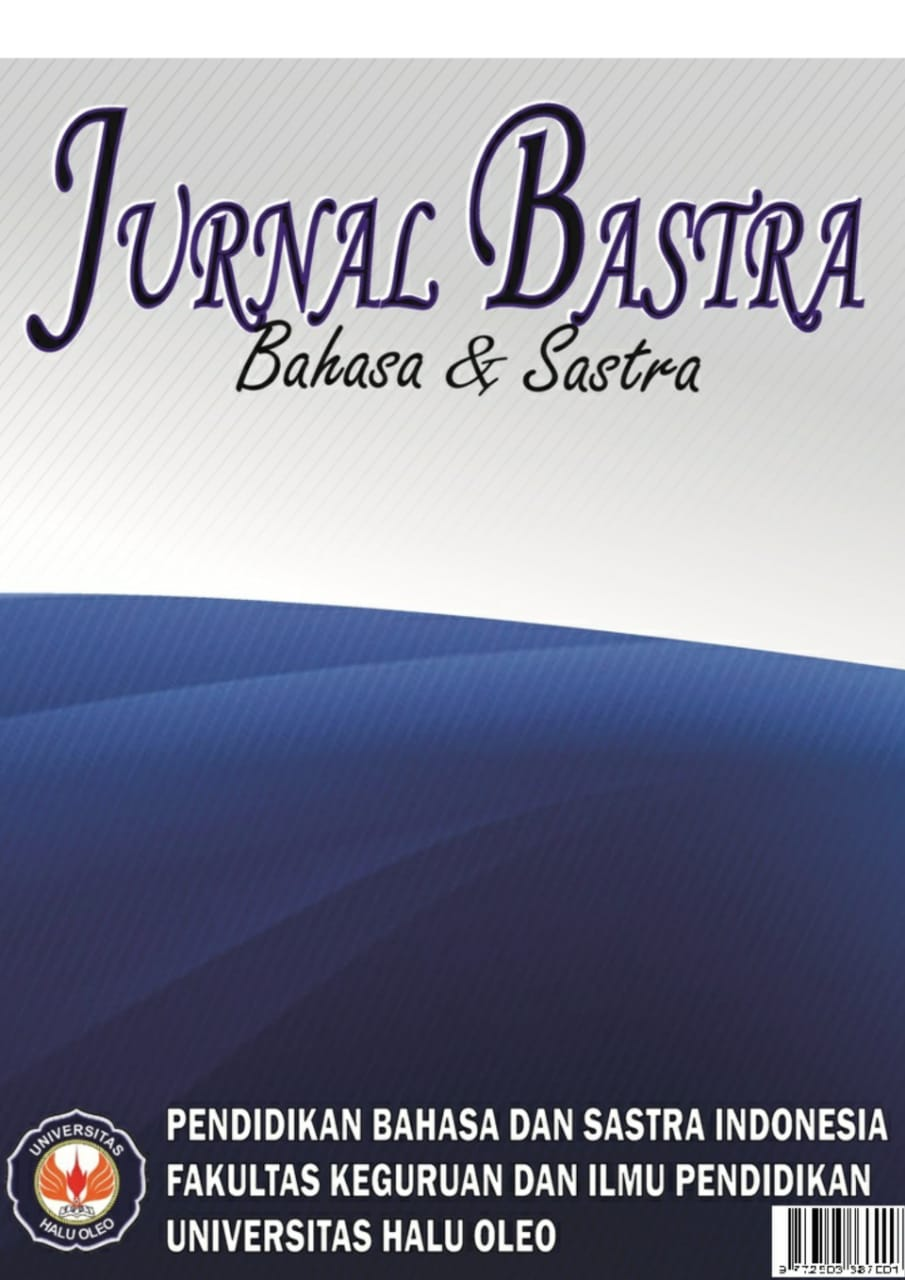FAKTA CERITA DALAM NOVEL ANGKASA DAN 56 HARI KARYA DESTASHYA WDP
DOI:
https://doi.org/10.36709/bastra.v9i4.781Keywords:
Story Facts; characters; plot and settingAbstract
The aim of this research is to find out the facts of the story in the novel Angkasa and 56 Days by Destashya WDP. The type of research used is library research. The research method is descriptive qualitative. The data are written documents in the form of words, sentences and paragraphs that express the facts of the story in the novel Angkasa and 56 Hari by Destashya WDP. The data sources are the novels studied, namely the novel Angkasa and 56 Days by Destashya WDP. The data collection techniques are literature and documentation. This analyzed using a structural approach. Based on the results of facts in the novels Angkasa and 56 Days by Destashya WDP, the following conclusions can be drawn: (1) The theme is the tortuous journey of the love story between Nadine and Angkasa. (2) The distribution used in the novel Angkasa and 56 Days by Destashya WDP uses a mixed distribution process. (3) There are 20 characters in the novel Angkasa and 56 Hari by Destashya WDP. (4) The setting inthe novel Angkasa and 56 Hari by Destashya WDP has three types of setting, place setting, time setting and social setting. (5) Description of the relationship between the characters and the plot, Angkasa and Nadine who dominate all the events in the story. (6) Description relationship between characters and the setting. The description characters is supported by the setting, namely, all information regarding: place, time and social setting where the actions occur in the novel.
References
Aan, S. dan Djam’an, S. (2017). Metodologi Penelitian Kualitatif. Bandung: Alfabeta.
Andri, W. 2014. Pengkajian Prosa Fiksi. Yogyakarta: Garudhawaca.
Bastra, J. et al. (2022) .Fakta cerita dan nilai pendidikan karakter dalam novel hijab palsu karya kifa ansu.7(4)
Bogdan dan Taylor, 2010 J. Moleong, Lexy. 1989. Metodologi Penelitian Kualitatif. Bandung: Remadja Karya.
Hasniati.2018. Eksistensi Tokoh Ayah Dalam Novel Ayah Karya Andrea Hiratan dan Novel Ayahku (Bukan) Pembohong Karya Tere Liye. Jurnal Master Bahasa. Vol.6, No.3.
Ilm, P.D. (2016). Analisis Fakta Cerita Dalam Novel Sayang Tanah. 1(2).
Isdriani, P. 2009. Seribu Pena Bahasa Indonesia untuk SMA/MA Kelas XII. Jakarta: Erlangga. Hal.138.
Isnawati, E. 2013. Pengajaran Sastra. Yogyakarta :Penerbit Ombak.
Kartikasari A, dan Edy S. 2018. Kajian Kesusastraan(Sebuah Pengantar). Jawa Timur: Cv. Ae Media Grafika.
Kemdikbud. 2020. Modul Tema 14 Menjadi Penulis Itu Asyik, lho! Bahasa Indonesia Paket C Setara SMA/MA Kelas XII.
Mulyana, R. 2004. Mengartikulasikan Pendidikan Nilai. Bandung: Alfabeta.
Nugiyantoro, B. 2015. Teori Pengkajian Fiksi. Cetakan IX. Yogyakarya: Gajah Mada University Press.
Prihantini, A. 2015. Master Bahasa Indonesia. Yogyakarta:Bentang Pustaka.
Rahayu, N.S. 2014. Pemimpin Perempuan : ikon Perempuan atau ikon feminis?.
Ratna, N. K. 2013. Teori Metode dan Penelitian Sastra dan Strukturalisme Hingga Prokstrukturalisme Perspektif Wacana Naratif. Yogyakarta: Pustaka Pelajar.
Risdi, A. 2019.Nilai-Nilai Sosial Tinjauan Dari Sebuah Novel. Lampung: Cv. Iqro.
Rosmaida, N. (2024). Fakta cerita dalam novel ingkar karya boy candra 1. 9(1), pp. 33–38.
Salim, A. 2002. Perubahan sosial. Yogyakarta : PT. Tiara Wacana Yogya. Djoened.
Sari, M. (2020) . Penelitian Kepustakaan ( Library Research ). 6(1), pp. 41–53.
Stanton, R. 2012. Teori Diksi Robert Stanton. Yogyakarta: Pustaka Pelajar.
Sugiyono.(2012). Metode Penelitian Kuantitatif Kualitatif dan R&D. Bandung: Penerbit Alfabeta.
Suryanto.2007. Cerdas Berfikir Bahasa dan Sastra Indonesia. Jakarta:Ganeca Exact. Hal.149.
Tarigan. 2000. Prinsip-prinsip Dasar Sastra. Bandung: Angkasa.






